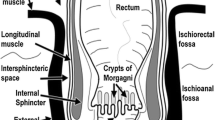Abstract
MRI is the standard modality in the pre- and post-treatment evaluation of patients with rectal cancer, particularly in those cases with locally advanced disease. We routinely employ a superparamagnetic iron oxide (SPIO) contrast enema to distend the rectal lumen and achieve maximal tumor-to-lumen contrast gradient. This practice also allowed the identification of a fistula in 24% of patients treated for rectal cancer. Contrast agent-related low intensity signal could be seen filling the tract and eventually opacifying surrounding organs (i.e., vagina) or collections (i.e., presacral abscess). Fistula formation after radiochemotherapy and surgery for rectal cancer is not uncommon. MRI with dark lumen contrast enema allows an effective demonstration of this complication in a high number of patients.



Similar content being viewed by others
References
Janjan NA, Khoo VS, Rich TA, et al. (1998) Locally advanced rectal cancer: surgical complications after infusional chemotherapy and radiation therapy. Radiology 206:131–136
Kosugi C, Saito N, Kimata Y, et al. (2005) Rectovaginal fistulas after rectal cancer surgery: incidence and repair by gluteal-fold flap repair. Surgery 137:329–336
Allal AS, Bieri S, Brundler MA, et al. (2002) Preoperative hyperfractionated radiotherapy for locally advanced rectal cancers: a phase I-II trial. Int J Radiat Oncol Biol Phys 54:1076–1081
Civelli EM, Gallino G, Valvo F, et al. (2002) Correlation between radiotherapy and suture fistulas following colo-anal anastomosis for carcinoma of the rectum. Evaluation of 152 consecutive patients. Tumori 88:321–324
Beets-Tan RGH, Beets GL (2004) Rectal cancer: review with emphasis on MR imaging. Radiology 232:335–346
Akasu T, Iinuma G, Fujita T, et al. (2005) Thin section MRI with a phased-array coil for preoperative evaluation of pelvic anatomy and tumor extent in patients with rectal cancer. AJR 184:531–538
Outwater E, Schiebler ML (1993) Pelvic fistulas: findings on MR images. AJR 160:327–330
Semelka RC, Hricak H, Kim B (1997) Pelvic fistulas: appearances on MR images. Abdom Imaging 22:91–95
Healy JC, Philips RR, Reznek RH, et al. (1996) The MR appearance of vaginal fistulas. AJR 167:1487–1489
Haldemann Heusler RC, Wight E, Marincek B (1995) Oral superparamagnetic contrast agent (ferumoxsil): tolerance and efficacy in MR imaging of gynecologic disease. J Magn Reson Imaging 5:385–391
Scheidler J, Heuck AF, Meier W, et al. (1997) MRI of pelvic masses: efficacy of the rectal superparamagnetic contrast agent Ferumoxsil. J Magn Reson Imaging 7:1027–1032
Sardanelli F, de Cicco E, Renzetti P, et al. (1999) Double-contrast magnetic resonance examination of ulcerative colitis. Eur Radiol 9:875–879
Blomqvist L, Ohlsen H, Hindmarsh T, et al. (2000) Local recurrence of rectal cancer: MR imaging before and after oral superparamagnetic particles vs contrast-enhanced computed tomography. Eur Radiol 10:1383–1389
Maier AG, Kersting-Sommerhoff B, Reeders JW, et al. (2000) Staging rectal cancer by double-contrast MR imaging using the rectally administered superparamagnetic iron oxide contrast agent ferristene and IV gadodiamide injection: results of a multicenter phase II trial. J Magn Reson Imaging 12:651–660
Fuchsjäger MH, Maier AG, Schima W, et al. (2003) Comparison of transrectal sonography and double-contrast MR imaging when staging rectal cancer. AJR 181:421–427
Author information
Authors and Affiliations
Corresponding author
Rights and permissions
About this article
Cite this article
Petrillo, A., Catalano, O., Delrio, P. et al. Post-treatment fistulas in patients with rectal cancer: MRI with rectal superparamagnetic contrast agent. Abdom Imaging 32, 328–331 (2007). https://doi.org/10.1007/s00261-006-9028-9
Published:
Issue Date:
DOI: https://doi.org/10.1007/s00261-006-9028-9




